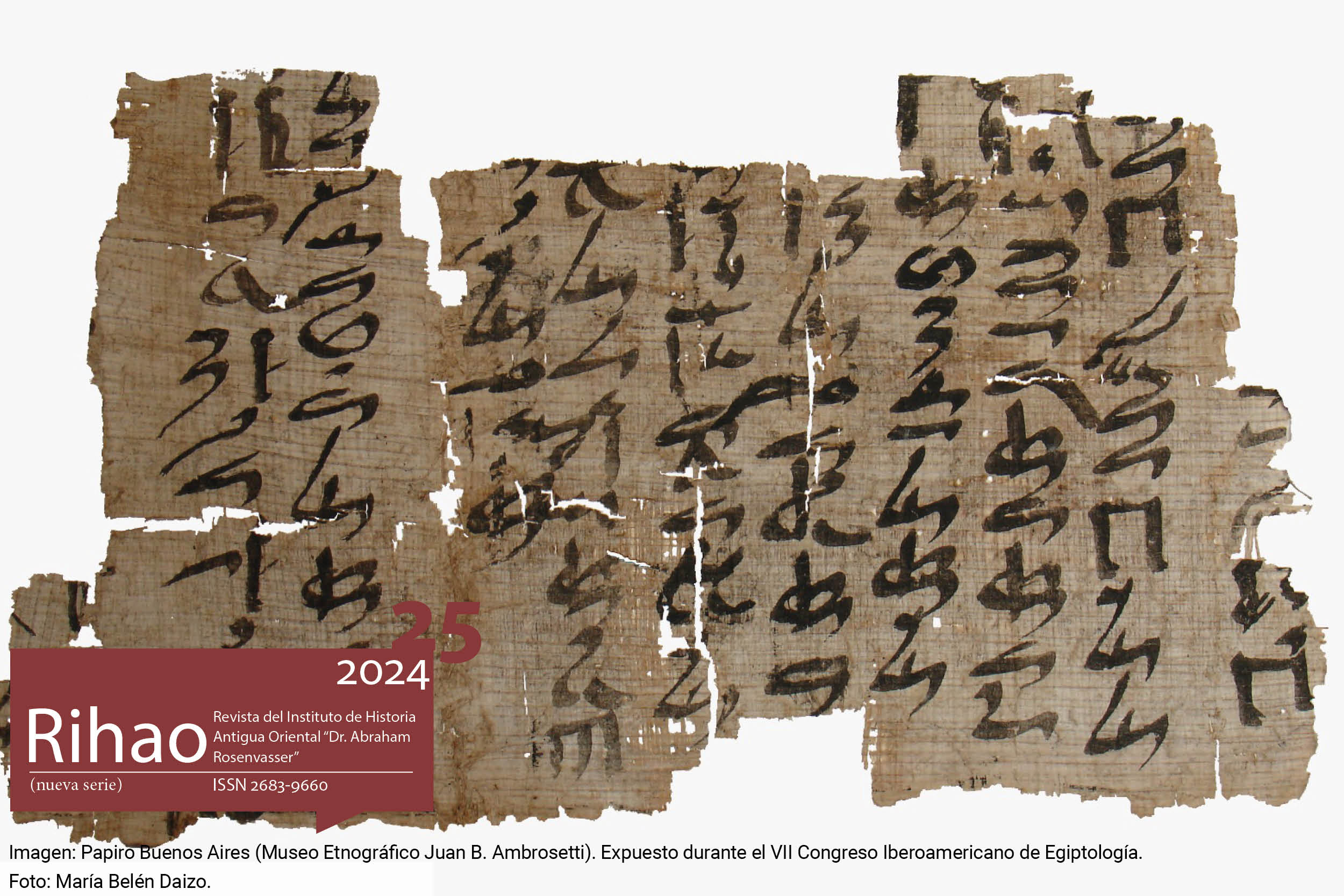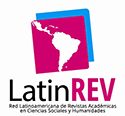La región Imhet: su significación espacial en la interacción de las cuarta y quinta horas del Libro del Amduat
Resumen
Los espacios de la topografía funeraria egipcia son generalmente traducidos como “Inframundo”, “Mundo de los Muertos” o “Más Allá” en la egiptología en español. En el denominado Libro del Amduat, composición funeraria representada en las tumbas reales desde la Dinastía 18, la co-existencia de distintos espacios en la inmensidad de la Duat es ostensible. Tanto Rosetau, Imhet y la denominada tierra de Sokar pueden en ocasiones aparecer como términos intercambiables o funcionalmente asimilables. En el caso particular de su cuarta y quinta horas, la interrelación funcional entre ambas nos muestra la topografía del Más Allá en toda su complejidad; en el espacio de la Duat se transita por los caminos de Rosetau y se desciende a la tierra de Sokar para confluir en la Imhet, la caverna más profunda de la Duat. Una lectura detallada que compare los contextos generales y particulares deviene necesaria para delimitar exactamente a qué se alude con cada uno de ellos. Nuestra propuesta es analizar el concepto de Imhet presente en el Libro del Amduat y ponerlo en relación con Rosetau, Duat y la tierra de Sokar, sin dejar de recorrer la literatura funeraria previa que lo menciona, así como su funcionalidad.Descargas
Citas
Abitz, F. (1974). Die religiöse Bedeutung der sogenannten Grabräuberschächte in den ägyptischen Königsgräbern der 18. bis 20. Dynastie (Ägyptologische Abhandlungen 26). Wiesbaden: Harrassowitz.
Abt, T. y Hornung, E. (2003). Knowledge for the Afterlife. The Egyptian Amduat - A Quest for Immortality. Zúrich: Living Human Heritage Publications.
Allen, J. (2006). Some aspects of the non-royal afterlife in the Old Kingdom, en: Bárta, M. (ed.), The Old Kingdom Art and Archaeology. Proceedings of the Conference held in Prague, May 31 - June 4, 2004. Praga: Publishing House of the Academy of Sciences of the Czech Republic, 9-18.
Alliot, M. (1949). Le culte d’Horus à Edfou au temps des Ptolémées. El Cairo: Institut français d‘archéologie orientale.
Altmann, V. (2010). Die Kultfrevel des Seth Die Gefährdung der göttlichen Ordnung in zwei Vernichtungsritualen der ägyptischen Spätzeit (Urk. VI) (Studien zur spätägyptischen Religion 1). Wiesbaden: Harrassowitz.
Assmann, J., Bommas, M. y Kucharek, A. (2005). Altägyptische Totenliturgien. Band 2. Totenliturgien und Totensprüche in Grabinschriften des Neuen Reiches. Heidelberg: Universitätsverlag Winter.
Assmann, J., Bommas, M. y Kucharek, A. (2008). Altägyptische Totenliturgien. Band 3. Osirisliturgien in Papyri der Spätzeit. Heidelberg: Universitätsverlag Winter.
Backes, B. (2005). Das altägyptische “Zweiwegebuch”: Studien zu den Sargtext-Sprüchen 1029-1130 (Ägyptologische Abhandlungen 69). Wiesbaden: Harrassowitz.
Barguet, P. (1976). Le Livre desCavernes et la reconstitution du corps divin, en: Revue d’Égyptologie 28: 25-37.
Barta, W. (1994). Komparative Untersuchungen zu vier Unterweltsbüchern. Fráncfort / Berna / Nueva York / París: Peter Lang.
Billing, N. (2011). Monumentalizing the Beyond. Reading the Pyramid before and after the Pyramid Texts, en: Studien zur Altägyptischen Kultur 40: 53-66.
Bleeker, C. (1967). Egyptian Festivals: Enactments of Religious Renewal. Leiden: Brill.
Burkard, G. (1995). Spätzeitliche Osiris-liturgien im corpus der Asasif-Papyri (Ägypten und Altes Testament 31).Wiesbaden: Harrassowitz.
Conman, J. (2007). Speculation on Special Sunlight and the Origin of the wSAwHour, en: Apuntes de Egiptología 3: 1-11.
Corteggiani, J. P. (1979). Une stèle Héliopolitaine d’époque Saïte, en: Vercoutter, J. (ed.), Hommages à la mémoire de Serge Sauneron, 1927-1976, vol. 1. El Cairo: Institut français d’archéologie orientale, 115-153.
Darnell, J. C. (2004). The Enigmatic Netherworld Books of the Solar-Osirian Unity (Orbis Biblicus et Orientalis 198). Friburgo / Gotinga: Universitätsverlag Vandenhoeck and Ruprecht.
Darnell, J. C. y Manassa Darnell, C. (2018). The Ancient Egyptian Netherworld Books (Writings from the Ancient World 39). Atlanta: SBL Press.
De Buck, A. (1935-1961). The Egyptian Coffin Texts, 7 vols. Chicago: The University of Chicago Press. [=TA]
Devauchelle, D. (1998). Une invocation aus dieux du Sérapéum de Memphis, en: Clarisse, W., Schoors, A. y Willems, H. (eds.), Egyptian Religion. The Last Thousand Years. Part I, Studies Dedicated to the Memory of Jan Quaegebeur. Lovaina: Peeters, 589-612.
Eaton, K. J. (2006). The Festivals of Osiris and Sokar in the Month of Khoiak: The Evidence from Nineteenth Dynasty Royal Monuments at Abydos, en: Studien zur Altägyptischen Kultur 35: 75-101.
Edwards, I. E. S. (1986). The Shetayet of Rosetau, en: Lesko, L. H. (ed.), Egyptological Studies in Honor of Richard A. Parker Presented on the Occasion of His 78th Birthday, December 10, 1983. Hanóver / Londres: University Press of New England, 26-36.
Erman A. y Grapow, H. (1971). Wörterbuch der Ägyptischen Sprache, 5 vols. Berlín: Akademie Verlag. [=Wb]
Faulkner, R. (1978). The Ancient Egyptian Coffin Texts,vol. 3. Warminster: Aris & Phillips.
Gabolde, M. (1995). L’inondation sous les pieds d’Amon, en: Bulletin de l’Institut français d’archéologie orientale 95: 235-258.
Gestermann, L. (1999). Königliche Vorstellungen zu Grab und Jenseits im Mittleren Reich, Teil II: Osirisgräber des Mittleren Reiches in königlichem Kontext: Amduat, 6. Stunde, en: Gundlach, R. y Seipel, W. (eds.), Das frühe ägyptische Königtum. Akten des 2. Symposiums zur ägyptischen Königsideologie in Wien 24.-26.9.1997 (Ägyptologische Abhandlungen 36, 2). Wiesbaden: Harrassowitz, 97-110.
Goyon, J.-C. (1999). Le Papyrus d’Imouthès, fils de Psintaes au Metropolitan Museum of Art de New-York (Papyrus MMA 35.9.21). Nueva York: The Metropolitan Museum of Art.
Graindorge-Héreil, C. (1994). Le Dieu Sokar à Thèbes au Novel Empire. Tome 1: Textes (Göttinger Orientforschungen IV, Reihe Ägypten, Band 28, 1). Wiesbaden: Harrassowitz.
Graves-Brown, C. (2008). Flint and Northern Sky, en: Schneider, T. y Szpakowska, K. (eds.), Egyptian Stories. A British Egyptological Tribute to Alan B. Lloyd on the Occasion of his Retirement (Alter Orient und Altes Testament 347). Münster: Ugarit Verlag, 111-137.
Hannig, R. (2009). Die Sprache der Pharaonen. Großes Handwörterbuch Ägyptisch-Deutsch (2800 - 950 v. Chr.). Marburgo: Philipp von Zabern.
Herbin, F. R. (1994). Le livre de parcourir l’éternité (Orientalia Lovaniensia Analecta 58). Lovaina: Peeters.
Herbin, F. R. (1999). La stèle Caire JE 72300, en: Jasnow, R. y Widmer, G. (eds.), Illuminating Osiris. Egyptological Studies in honor of Mark Smith. Atlanta: Lockwood Press, 99-133.
Hermsen, E. (1991). Die zwei Wege des Jenseits, das altägyptische Zweiwegebuch und seine Topographie (Orbis Biblicus et Orientalis 112). Friburgo: Universitätsverlag.
Hornung, E. (1963). Das Amduat. Die Schrift des verborgenen Raumes (Ägyptologische Abhandlungen 7, 2). Wiesbaden: Harrassowitz.
Hornung, E. (1981). Auf den Spuren der Sonne: Gang durch ein ägyptisches Königsgrab, en: Eranos Jahrbuch 50: 431-475.
Hornung, E. (1987-1994). Texte zum Amduat (Aegyptiaca Helvetica 13-15). Ginebra: Editions de Belles-Lettres.
Hornung, E. (1999). The Ancient Egyptian Books of the Afterlife. Ithaca: Cornell University Press.
Klotz, D. (2006). Adoration of the Ram: Five Hymns to Amun-Re from Hibis Temple (Yale Egyptological Studies 6). New Haven: Yale University Press.
Klotz, D. (2008). Kneph: The Religion of Roman Thebes. Tesis doctoral. New Haven: Yale University.
Kucharek, A. (2014). Frauen im Tempel. Zur Frage der Ritualakteure in den ʽKlageliedern von lsis und Nephthysʼ, en: Quack, J. (ed.), Ägyptische Rituale der griechisch-römischen Zeit. Proceedings of an international conference in Heidelberg in 2008. Tubinga: Mohr Siebeck, 185-199.
Leitz, C. (1989). Die obere und die untere Dat, en: Zeitschrift für ägyptische Sprache und Altertumskunde 116: 41-57.
Leitz, C. (2002). Lexikon der Ägyptischen Götter und Götterbezeichnungen, Band I (Orientalia Lovaniensia Analecta 110). Lovaina: Peeters.
Lesko, L. (1972). The Ancient Egyptian Books of Two Ways. Berkeley: University of California Press.
Lesko, L. (1991). Ancient Egyptian Cosmogonies and Cosmology, en: Shafer, B. E. (ed.), Religion in Ancient Egypt. Gods, Myths, and Personal Practice. Londres: Cornell University Press, 88-122.
Mikhail, L. B. (1984). The Festival of Sokar. An Episode of the Osirian Khoiak Festival, en: Göttinger Miszellen 82: 25-44.
Piankoff, A. (1954). The tomb of Ramesses VI, 2 vols. (Bollingen Series 40, 1). Nueva York: Pantheon Books.
Quirke, S. (2013). Going out in Daylight - prt m hrw: The Ancient Egyptian Book of the Dead, translation, sources, meanings. Londres: Golden House Publications.
Roberson, J. (2007). The Book of the Earth. A Study of Ancient Egyptian Symbols-Systems and the Evolution of New Kingdom Cosmographic Models. Tesis doctoral. Filadelfia: University of Pennsylvania.
Rößler-Köhler, U. (1986). Sepa, en: Lexikon der Ägyptologie V. Wiesbaden: Harrassowitz, cols. 859- 863.
Rößler-Köhler, U. (1999). Königliche Vorstellungen zu Grab und Jenseits im Mittleren Reich, Teil I: Ein “Gottesbegräbnis” des Mittleren Reiches in königlichem Kontext: Amduat, 4. und 5. Stunde, en: Gundlach, R. y Seipel W. (eds.), Das frühe ägyptische Königtum: Akten des 2.Symposiums zur ägyptischen Königsideologie in Wien 24.-26.9.1997. Wiesbaden: Harrassowitz, 73-96.
Rull Ribó, D. (2012). Los verbos ascensionales en los Textos de las Pirámides. Una aproximación léxica y cultural. Tesis de doctorado. Barcelona: Universidad Autónoma de Barcelona.
Sakovich, A. (2005-2006). Explaining the Shafts in Khufu’s Pyramid at Giza, en: Journal of the American Research Center in Egypt 42: 1-12.
Schäfer, H. (1905). Urkunden der Älteren Äthiopenkönige I. Leipzig: J. C. Hinrichs.
Smith, M. (2009). Traversing Eternity. Texts for the Afterlife from Ptolemaic and Roman Egypt. Oxford:Oxford University Press.
Spalinger, A. (2018). Feasts and Fights. Essays on Time in Ancient Egypt (Yale Egyptological Studies 10). New Haven: Yale University Press.
Stadler, M. A. (2012). Funerary Religion. The Final Phase of an Egyptian Tradition, en: Riggs, C. (ed.), Oxford Handbook of Roman Egypt. Oxford: Oxford University Press, 383-397.
Tobin, V. (1989). Theological Principles of Egyptian Religion (American University Studies, Serie VII Theology and Religion). Nueva York: Peter Lang.
Töpfer, S. (2016). Teile des Totenbuches des Anch-ef-en-Chonsu, Sohn des Bes-en-Mut in der Österreichischen Nationalbibliothek (Papyrus Wien Aeg. 12022a+b), en: Studien zur Altägyptischen Kultur 45: 375-388.
van der Molen, R. (2000). A Hieroglyphic Dictionary of Egyptian Coffin Texts (Probleme der Ägyptologie 15). Leiden: Brill.
Wagner, M. (2015). Das Buch zur Verklärung des Ach, en: Backes, B. y Diehlemann, J. (eds.), Liturgical Texts for Osiris and the Deceased in Late Period and Greco-Roman Egypt. Collected Proceedings of the Colloquiums at New York (ISAW), 6 May 2011, and Freudenstadt, 18-21 July 2012 (Studien zur spätägyptischen Religion 14). Wiesbaden: Harrassowitz, 179-202.
Wegner, J. (2009). The tomb of Senwosret III at Abydos: considerations on the origins and development of the royal Amduat-tomb, en: Silverman, D. P., Simpson, W. K. y Wegner, J. (eds.), Archaism and Innovation: Studies in the Culture of Middle Kingdom Egypt. New Haven / Filadelfia: Metropolitan Museum of Art, 103-169.
Wilson, J. (1997). A Ptolemaic Lexikon: A Lexicographical Study of the Texts in the Temple of Edfu(Orientalia Lovaniensia Analecta 78). Lovaina: Peeters.
Zago, S. (2018). Imagining the Beyond: The Conceptualization of Duat between the Old and the Middle Kingdoms, en: Journal of the American Research Center in Egypt 54: 203-217.
Zago, S. (2019). Conceptualizing Life after Death: The Evolution of the Concept of Duat and Related Notions in Egyptian Funerary Literature. Tesis de doctorado. Toronto: University of Toronto.
Zago, S. (2022a). A Journey through the Beyond: The Development of the Concept of Duat and Related Cosmological Notions in Egyptian Funerary Literature. Atlanta: Lockwood Press.
Zago, S. (2022b). The Otherworld (with)in This World: Imhet as a (Super)natural Conduit between Dimensions in Egyptian Sources, en: Journal of Near Eastern Studies 81 (2): 283-304.
Derechos de autor 2024 Mariano Bonanno

Esta obra está bajo licencia internacional Creative Commons Reconocimiento-NoComercial 4.0.





.jpg)







